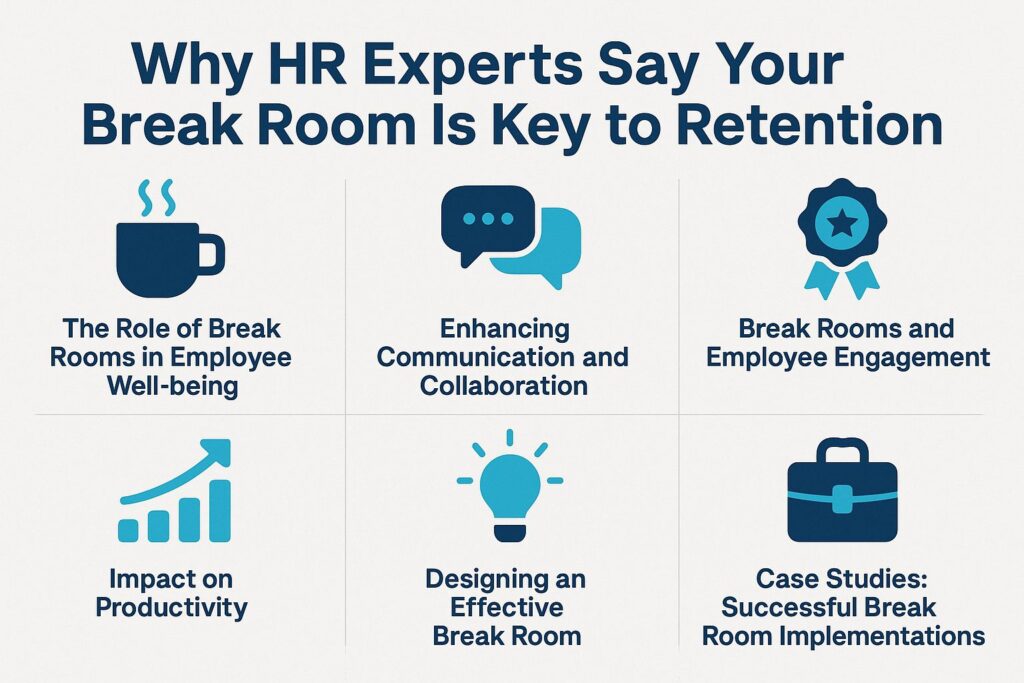
Why HR Experts Say Your Break Room Is Key to Retention
Think your break room is just a place for coffee and snacks? Think again. HR experts are emphasizing its key role in keeping employees. A thoughtfully created break room shows your company values, improves health, encourages conversation, and increases employee commitment. Learn how this frequently ignored area can increase involvement, work output, spirits, and promote a feedback culture. Ready to transform your workplace? Let’s dive into why your break room matters more than you might realize.
The Importance of Employee Retention
Investing in employee retention strategies can reduce turnover costs by as much as 50%, which includes hiring and training new hires and improving recruitment strategies.
Companies such as Google and Zappos have greatly increased employee retention by providing customized programs. For instance, Google’s ‘Career Gurus’ initiative pairs employees with mentors, enhancing growth opportunities.
Zappos focuses on building a positive workplace and ensuring employees are happy, holding frequent feedback meetings to quickly deal with any issues. Statistics show that companies with high retention rates often boast employee satisfaction scores exceeding 80%, underscoring the financial advantages of a dedicated retention strategy and proactive measures.
Organizations can increase commitment and lower staff departures by prioritizing involvement, growth opportunities, and employee advocacy.
Break Rooms as a Reflection of Company Culture
A well-designed break room showcases a commitment to employee well-being, influencing 71% of employees’ perception of their company’s culture.
To improve the workplace environment and employee experience, think about adding things like:
- Cozy seating
- Shared coffee areas
- Games for relaxation
Comfortable seating helps people relax and talk informally, supporting teamwork among colleagues and promoting informal meetings. A well-equipped coffee station provides a way for employees to recharge with caffeine, relax, chat with coworkers, and strengthen cooperation. Including games like foosball or board games encourages working together, helps lower stress, and supports social interaction.
These well-considered features show a company’s principles and encourage a positive work environment, which increases employee involvement and happiness.
The Role of Break Rooms in Employee Well-being
Break rooms offer employees a place to relax, helping them feel comfortable, maintain good mental health at work, and support work-life balance. Creating a well-balanced environment also involves smart choices like integrating healthy vending options. Benefit-focused: Discover the top benefits of healthy vending machines in the workplace and how they complement break room functionality.
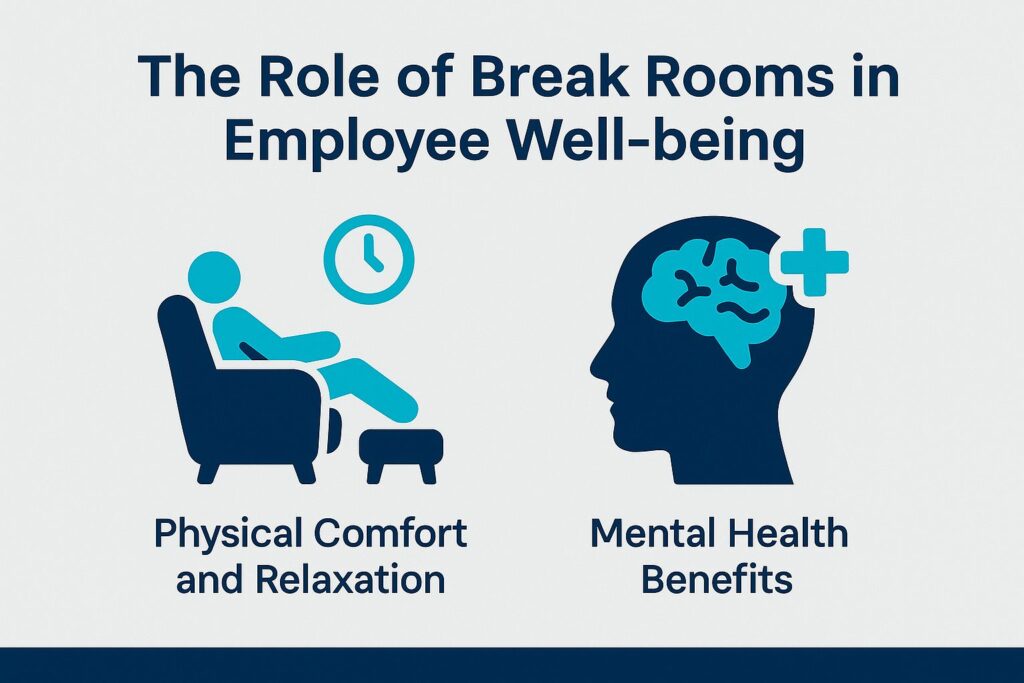
Physical Comfort and Relaxation
Adding ergonomic furniture and relaxation areas in break rooms can improve physical comfort, cutting down fatigue by 30% for employees, and contributing to health benefits.
Companies like Google and Microsoft have successfully integrated ergonomic chairs and standing desks into their office layouts, promoting better posture and increased productivity.
Incorporating quiet zones with soft seating and adjustable lighting allows employees to unwind and recharge during breaks. For instance, Salesforce has designated areas with plants and art to create a calming environment, enhancing workplace amenities.
These deliberate design decisions increase comfort and encourage creativity and teamwork, leading to a workforce that is more involved. By investing in such features, employers can significantly improve overall employee well-being.
Mental Health Benefits
A thoughtfully designed break room can reduce stress levels by 20%, leading to improved mental health among employees.
Creating a break room with areas for relaxation can greatly improve employee morale, offering stress relief. For example, having cozy chairs and including soothing things like plants or artwork can create a peaceful setting.
A study by the University of Exeter found that employees with access to a well-equipped break room reported a 25% increase in focus and productivity.
Providing snacks and drinks helps people talk to each other, reduces stress, and increases casual interactions. Regularly checking what employees think about break room features helps keep them useful and up-to-date, encouraging employee feedback.
Enhancing Communication and Collaboration
Break rooms encourage casual conversations that improve communication and help employees work together better.
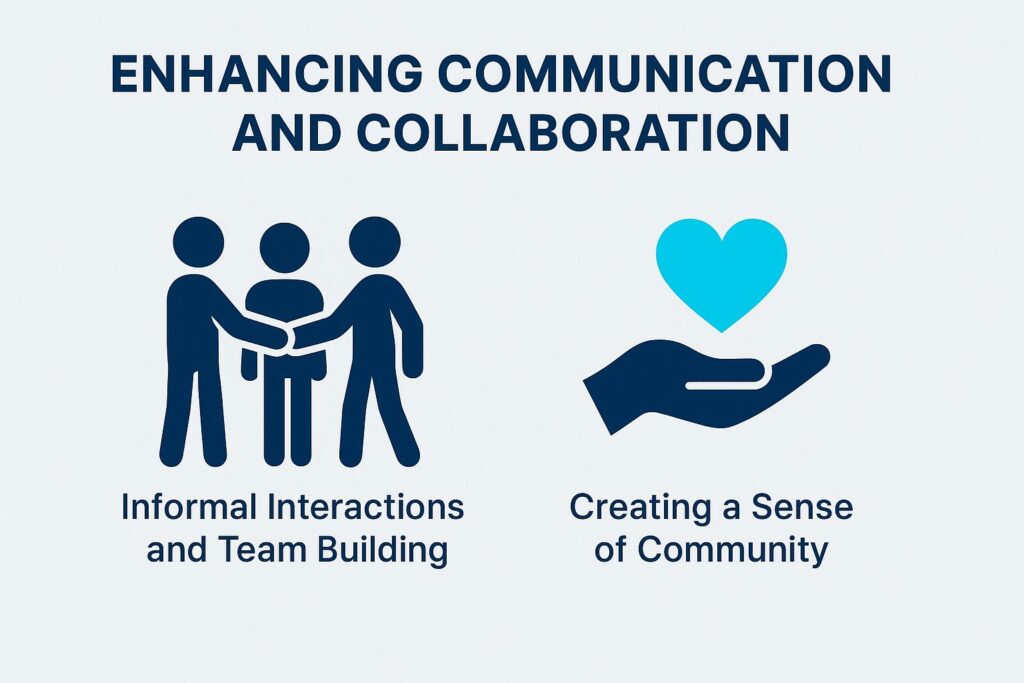
Informal Interactions and Team Building
Encouraging informal interactions in break rooms can increase teamwork effectiveness by up to 50%, strengthening workplace relationships.
To capitalize on this, consider organizing team-building activities like game days or cooking contests.
For instance, hosting a weekly trivia challenge can spark friendly competition and encourage collaboration.
You could set up a ‘coffee chat’ rule, where employees are encouraged to take breaks together, encouraging informal talks.
Using tools like Slack or Microsoft Teams can make it easier to have informal chats by setting up casual conversation channels.
These efforts lead to a good atmosphere, raising spirits, motivation, and output.
Creating a Sense of Community
A break room designed for socialization can instill a sense of community, improving employee satisfaction scores by 40% and building professional relationships.
For instance, Google’s break rooms feature cozy seating, games, and snack stations, encouraging employees to unwind and interact. In a similar way, Salesforce set up ‘Ohana Rooms’ for casual meetings, encouraging teamwork and building closer team connections.
Companies should consider incorporating elements like open space, collaboration zones, and refreshments:
- Communal dining tables
- Whiteboards for brainstorming
- Comfortable lounge areas
Weekly coffee chats in these areas can strengthen community connections and support networking. These initiatives raise morale and lead to higher productivity, creativity, and employee engagement among staff.
Break Rooms and Employee Engagement
Break rooms are important for improving employee involvement and supporting employee development by offering areas where creativity and new ideas can develop naturally.

Encouraging Creativity and Innovation
Having open, comfortable spaces in break rooms can increase creativity by 35%, resulting in new solutions and ideas.
Companies like Google and Facebook have successfully integrated design elements that promote relaxation and inspiration in their break rooms.
For instance, Google’s break spaces feature colorful furniture and art installations, which provide an inviting atmosphere for spontaneous brainstorming sessions. Facebook also has outdoor spaces with plants and cozy seating where employees can take breaks and relax.
Using art displays, natural light, and flexible seating arrangements can help create a space where creativity grows, leading to more teamwork, innovation, and new ideas.
Boosting Morale through Socialization
Regular socialization opportunities in break rooms can lead to a 25% increase in overall employee morale.
This improvement in morale is often connected to better job satisfaction and strong team unity. For instance, companies implementing scheduled coffee breaks or casual Friday lunches report a notable reduction in employee turnover.
Surveys reveal that 65% of workers feel more engaged and valued in environments where informal interactions are encouraged.
Providing simple tools, such as games for everyone or shared coffee spaces, can help people connect, improving teamwork. Creating a relaxing break room can strengthen relationships outside of work, leading to a more welcoming environment and boosting overall job satisfaction.
Impact on Productivity
Break rooms greatly influence productivity and workplace efficiency. Studies indicate that brief breaks can improve work performance by 10-20%. Healthy eating during these breaks can further enhance employee well-being and productivity.
Related insight: Top Benefits of Healthy Vending Machines in the Workplace
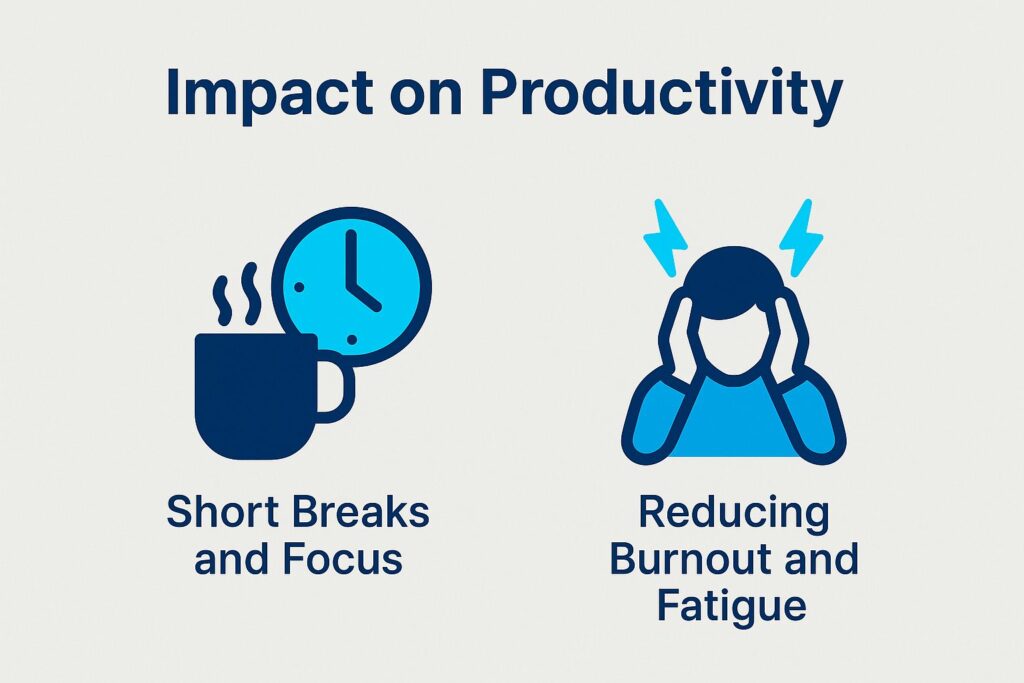
Short Breaks and Focus
Research indicates that taking short breaks every 90 minutes can increase focus and efficiency by 30%.
To implement this effectively, consider techniques like the Pomodoro Technique, where you work for 25 minutes followed by a 5-minute break, then take a longer break after four cycles.
Use apps like Focus@Will or Pomodone as productivity tools to track sessions and remind you when to rest. During breaks, engage in activities like stretching, a quick walk, or breathing exercises to refresh your mind.
This structured approach can help prevent burnout and maintain cognitive function throughout the day.
Reducing Burnout and Fatigue
Taking regular breaks can reduce burnout by 40%, resulting in a healthier work environment.
To maximize the benefits of break rooms, consider creating a space that encourages relaxation and social interaction, supporting employee recognition programs.
- Provide different snacks and drinks, like fruits, herbal teas, and coffee, to keep employees refreshed.
- Use comfortable seats, plants, and calming decorations to improve the atmosphere.
- Encourage team members to take turns leading informal activities like games or mindfulness sessions.
A study from the University of California found that even short breaks can significantly increase productivity and creativity, demonstrating the importance of downtime in combating workplace fatigue and burnout prevention.
Designing an Effective Break Room
A good break room looks nice and works well, including design features that improve the employee experience and reflect company values.
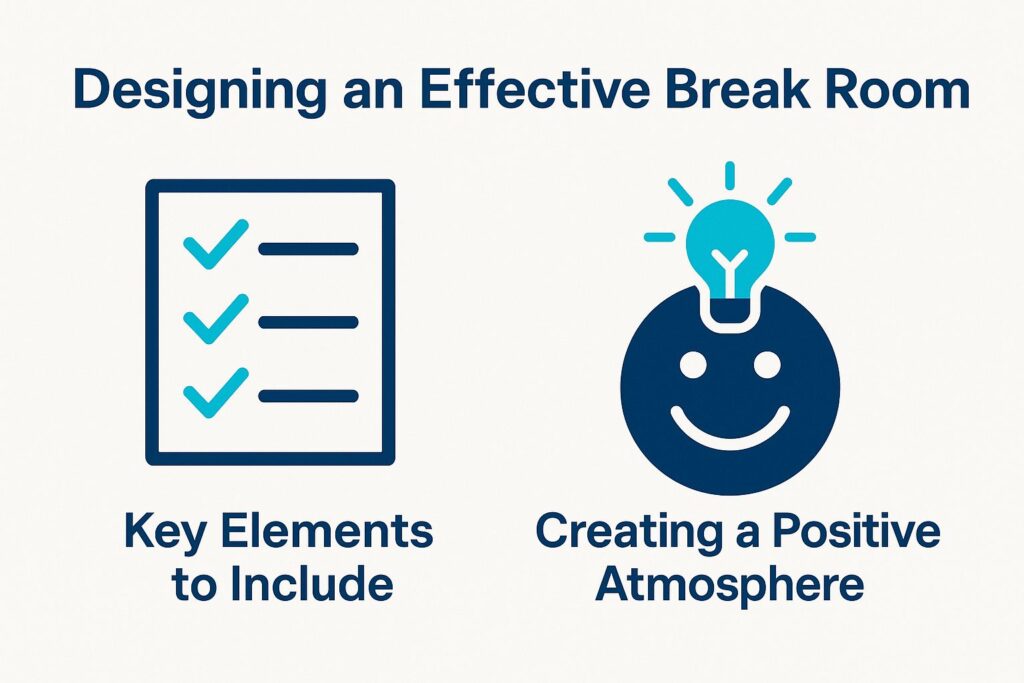
Key Elements to Include
Comfortable chairs, coffee areas, and relaxation zones can make break rooms more convenient and create a friendly environment.
Using ergonomic furniture like chairs that can be adjusted and desks for sitting or standing increases comfort, promotes movement, and supports workplace flexibility. For example, Google famously includes various seating options to cater to diverse work styles.
Coffee stations equipped with high-quality machines, like Breville or Keurig, facilitate quick breaks, improve morale, and offer rewards and recognition. Creating dedicated relaxation areas with soft furnishings and greenery can promote mental well-being and employee contributions.
Companies like Dropbox have successfully implemented these features, resulting in increased employee satisfaction, productivity, and demonstrating effective engagement strategies, proving that thoughtful design can lead to a more engaged workforce.
Creating a Positive Atmosphere
Decorating the office and using good lighting can make employees happier, improve workplace culture, and increase involvement by up to 30%.
To achieve this, start by choosing uplifting colors like soft blues and greens, which promote calmness and creativity.
Make use of plenty of natural light to help with stress relief; if unavailable, select warm LED bulbs that resemble daylight.
Adding plants to a room improves its appearance, cleans the air, reduces stress, and creates a better work atmosphere by managing resources.
Consider hanging artwork that reflects your company’s values or local culture to create a sense of connection and promote diversity.
Together, these elements can turn a break room into a refreshing spot for employees.
Final Thoughts on Break Room Importance
Investing in quality break rooms boosts employee morale, increases work efficiency, and creates a better work environment.
Creating inviting break rooms can include elements such as comfortable seating, access to natural light, and calming decor. For example, you might provide ergonomic chairs and tables, ensuring employees can unwind effectively.
Using digital tools like a coffee machine with custom settings or a mini fridge stocked with healthy snacks can make the experience better. Consider including plants or artwork to promote a calming atmosphere.
By focusing on these features, companies encourage teamwork, refreshment, and motivation strategies, which raise morale and increase productivity.
Call to Action for HR Leaders and Human Resources Professionals
HR leaders should focus on setting up break rooms as an important way to increase employee happiness, keep workers from leaving, and improve how the organization functions.
To make a significant impact, consider these actionable steps:
- Renovate the space to include comfortable seating and modern appliances, ensuring a welcoming environment and effective office design.
- Introduce healthy snack options such as fresh fruits and nuts to promote wellness.
- Create a way for employees to share their ideas for improvements or to say which amenities they find most important, encouraging positive feedback.
- Think about adding relaxation areas with soothing decorations, like plants, to create a calm environment and support social spaces.
By focusing on these specific initiatives, HR leaders can create a break room that truly supports employee well-being and team success.
About the Author
Ethan Cole is a business growth advisor and serial entrepreneur with over two decades of hands-on experience helping startups and small businesses thrive. With a background in finance and operations, he’s led multiple companies from early-stage concepts to multi-million-dollar exits. Ethan specializes in scaling strategies, cost reduction, and building systems that support sustainable growth. As a content contributor for Kwote Advisor, he shares practical insights to help business owners make smarter decisions when launching, managing, and expanding their ventures.



